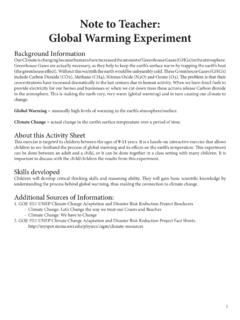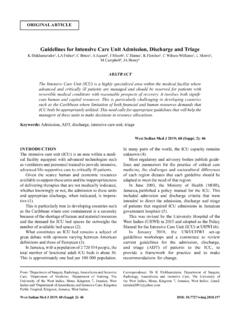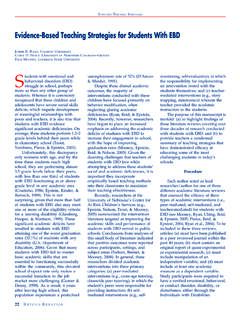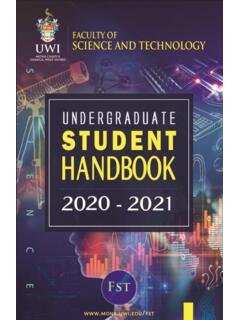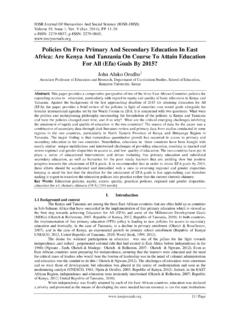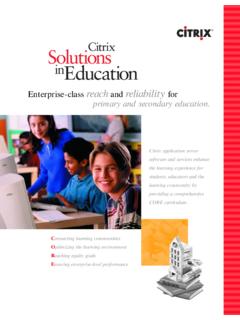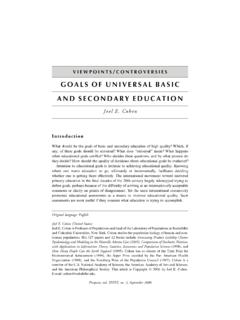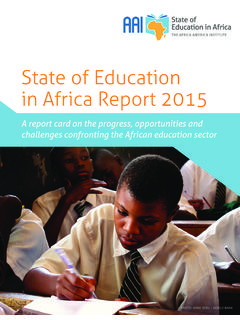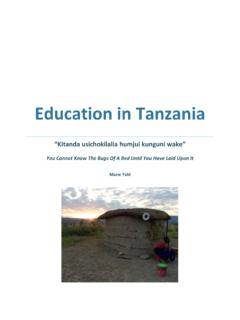Transcription of DEVELOPMENT OF A CARICOM STRATEGIC PLAN FOR …
1 CONCEPT PAPER DEVELOPMENT OF A CARICOM STRATEGIC PLAN FOR primary AND secondary education SERVICES IN THE CARICOM SINGLE MARKET AND ECONOMY (CSME) By Dr. Didacus Jules Registrar Caribbean Examinations Council 2 Contents Introduction & Overview 04 Policy Framework for primary & secondary 16 The Continuum of education : Cross Sectoral Linkage 24 Constraints: From Inhibition to Enabler 25 Recommendations 26 Bibliography 28 Appendix 1 CARICOM Statement of the Ideal Caribbean Person 29 Appendix 2 Structure of CARICOM National education Systems 30 Appendix 3 CARICOM School Age Populations 32 Appendix 4 Bio-sketch of Consultant 33 3 Acronyms CSEC Caribbean secondary education Certificate CAPE Caribbean Advanced Proficiency Examinations CCSLC Caribbean Certificate of secondary Level Competence
2 CSME Caribbean Single Market & Economy CEE Common Entrance Exam CVQ Caribbean Vocational Qualification CXC Caribbean Examinations Council ECE Early Childhood education EFA education for All GDP Gross Domestic Product OECS Organization of Eastern Caribbean States OERU OECS education Reform Unit UNESCO United Nations Educational, Scientific and Cultural Organization UPE Universal primary education USE Universal secondary education 4 Introduction & Overview From the inception of the regional integration movement, the narrative has always maintained the focus on people as central to the process of bringing the Caribbean together and it is vital if this is to be attained - that an effective functional framework for education and human resource DEVELOPMENT be constructed.
3 Given the textured history of regional collaboration, it is important too that this architecture build on that experience and take account of national idiosyncrasies. Some underlying principles that ought to be observed include: Functional collaboration in education should start with essential lines of convergence that would add value to the national as well as the regional agenda. The agenda, while establishing a minimum common framework, should always allow a window of flexibility within which national authorities can address particular needs. Philosophical Introduction This policy paper seeks to address issues in BASIC education defined as the continuum of education provision from early childhood to primary to secondary education (incorporating also technical and vocational education ).
4 Too often studies of this nature have focused on primary and secondary education and ignored the vital importance of pre- primary or early childhood education in laying the foundation for achievement in later years. Additionally, the pace of globalisation and the impact of the technological revolution have made higher education a developmental imperative and have made it necessary to redefine basic education as inclusive of secondary education . The paper therefore treats basic education as the new minimum but holistic educational standard that the region is expected to deliver to its citizens.
5 Two philosophical underpinnings There are two philosophical postures underlying this strategy and they derive from: 5 1. UNESCO Imperatives for Learning in the 21st Century learning to learn, learning to be, learning to do and learning to live together encapsulate the critical competencies required for navigating the challenges of this historical era. The table below details the policy and curriculum implications of these learning imperatives for national education systems. Source: Jules 2001 2. Statement of the Ideal Caribbean Person This statement, approved by CARICOM Heads in 1996, identifies the essential characteristics of the ideal Caribbean person and ought to be adopted as one of the philosophical aims of education in the region.
6 Like the UNESCO Imperatives, it speaks to the holistic and integral DEVELOPMENT of the person and the relationship to others and to the environment. 6 Some key questions The key questions that we need to address at the regional level include: To what extent are our education systems providing the knowledge, skills and competencies required to not just survive but thrive in today's globally competitive environment? To what extent is education in the Caribbean promoting the ideals of and facilitating the regional integration movement and providing the skills and knowledge vital to its realization is education assisting in the formation of the Ideal Caribbean Person?
7 To what extent is education contributing to the eradication of social inequality and providing an avenue for emancipation from poverty of pocket and spirit? What are the essential elements of an adequate framework for harmonization of education across the region which would add value to national education systems and progressively foster regional integration? These issues have been factored into the strategy outlined in this paper. Definition, Scope & Coverage of the Basic education Sector Comparative charts and statistics As a region, basic education coverage in the Caribbean compares favorably with developing countries.
8 The age coverage of the sector across the region ranges as follows: SECTOR AGE RANGE COMMENTS Pre- primary 3-4 Almost uniformly ranging from ages 3-4 in CARICOM member states primary 5-11 Generally ages 5-11 except for Bahamas (5-10), Belize (5-12), Jamaica (5-10) and Netherlands Antilles (6-11) secondary 12-18 secondary education provision is more textured across the region with spans ranging from a low of 4 years in Belize to 7 years in St. Vincent & the Grenadines. Average span for the region is 5 years. Mandatory provision reaches as high as the 18 year age cohort in St.
9 Vincent and the earliest provision is for the 11 year age cohort in the Bahamas. 7 The total pre- primary school age population of the Caribbean is 1,043,445; the total primary school age population is 2,206,043 while the secondary school age population is 2,213,251 (all inclusive of Haiti). Excluding Haiti which is a major non-English speaking demographic this population shrinks to 289,832 for the pre- primary age population, 754,759 for the primary age population and 635,701 for the secondary age population. The fact that the Anglophone Caribbean accounts for of the total school age population raises critical policy concerns for a regional basic education strategy which will be explored later.
10 A World Bank study on Monitoring Educational Performance in the Caribbean , after analysing statistics for 10 countries, reported the following conclusions: primary level coverage was no longer generally a problem in the region. secondary level coverage coverage and completion was an issue of concern. While great progress has been made in the last five years on access to secondary education , the number of dropouts at that level is the most serious concern. Internal efficiency measured by survival rates to the last grade of secondary and repetition rate is generally low in the region.



